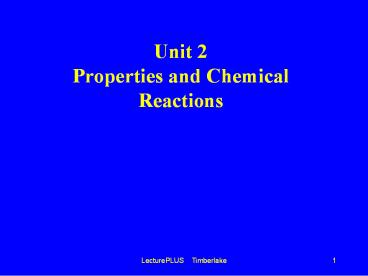Unit 2 Properties and Chemical Reactions - PowerPoint PPT Presentation
1 / 19
Title:
Unit 2 Properties and Chemical Reactions
Description:
Unit 2 Properties and Chemical Reactions LecturePLUS Timberlake * LecturePLUS Timberlake * Physical Properties color melting point boiling point electrical ... – PowerPoint PPT presentation
Number of Views:95
Avg rating:3.0/5.0
Title: Unit 2 Properties and Chemical Reactions
1
Unit 2 Properties and Chemical Reactions
2
Physical Properties
- color
- melting point
- boiling point
- electrical conductivity
- specific heat
- density
- state (solid, liquid, or gas)
3
Physical Change
- Changes in physical properties
- melting
- boiling
- condensation
- No change occurs in the identity of the
substance - Example
- Ice , rain, and steam are all water
4
Chemical Change
- Atoms in the reactants are rearranged to form one
or more different substances - Old bonds are broken new bonds form
- Examples
- Fe and O2 form rust (Fe2O3)
- Ag and S form tarnish (Ag2S)
5
Learning Check E1
- Classify each of the following as a
- 1) physical change or 2) chemical change
- A. ____ a burning candle
- B. ____ melting ice
- C. ____ toasting a marshmallow
- D. ____ cutting a pizza
- E. ____ polishing silver
6
Solution E1
- Classify each of the following as a
- 1) physical change or 2) chemical change
- A. __2__ a burning candle
- B. __1_ melting ice
- C. __2__ toasting a marshmallow
- D. __1__ cutting a pizza
- E. __2__ polishing silver
7
Chemical Reaction
- A process in which at least one new substance is
produced as a result of chemical change.
8
A Chemical Reaction
- Reactants Products
9
Learning Check E2
- A. How does an equation indicate a change in
- the identity of the reacting substances?
- B. How did the yellow and green reactants
- combine?
- C. Did all the reactants form product? Why or
- why not?
10
Learning Check E2
- A. How does an equation indicate a change in
- the identity of the reacting substances?
- The formulas of the reactants are different
- than the formulas of the products.
- B. How did the yellow and green reactants
- combine? 1 yellow combined with 1 green.
- C. Did all the reactants form product? Why or
- why not? No. There were more yellow
- reactants than green.
11
Writing a Chemical Equation
- Chemical symbols give a before-and-after
picture of a chemical reaction - Reactants Products
- MgO C CO Mg
- magnesium oxide to form carbon monoxide
- reacts with carbon and
magnesium
12
Learning Check E3
- 12 oz of dough, 4 oz mushrooms, 12 slices
pepperoni, 8 oz cheese and 5 oz tomato sauce are
used to make a pizza. Write a recipe in words
for putting together a pizza. - How would you write the recipe as an equation?
13
Solution E3
- Example Combine 12 oz dough 4 oz mushrooms
12 slices pepperoni 8 oz cheese 5 oz tomato
sauce and heat 30 minutes at 350C to produce 1
pizza - 12 oz dough 4 oz mshrm
- 12 pep 8 oz chse 1 pizza
- 5 oz tom sauce
14
Reading A Chemical Equation
- 4 NH3 5 O2 4 NO 6 H2O
- Four molecules of NH3 react with five molecules
O2 to produce four molecules NO and six molecules
of H2O - or
- Four moles NH3 react with 5 moles O2 to produce
four moles NO and six moles H2O
15
A Balanced Chemical Equation
- Same numbers of each type of atom on each side
of the equation - Al S Al2S3
Not Balanced - 2Al 3S Al2S3
Balanced
16
Matter Is Conserved
- H2 Cl2 2 HCl
- Total atoms Total atoms
- 2 H, 2 Cl 2H, 2 Cl
- Total Mass Total Mass
- 2(1.0) 2(35.5) 2(36.5)
- 73.0 g 73.0 g
17
Law of Conservation of Mass
- In any ordinary chemical reaction, matter is not
created nor destroyed
18
Learning Check E4
- Fe3O4 4 H2 3 Fe 4 H2O
- A. Number of H atoms in 4 H2O
- 1) 2 2) 4 3) 8
- B. Number of O atoms in 4 H2O
- 1) 2 2) 4 3) 8
- C. Number of Fe atoms in Fe3O4
- 1) 1 2) 3 3) 4
19
Solution E4
- Fe3O4 4 H2 3 Fe 4 H2O
- A. Number of H atoms in 4 H2O
- 3) 8
- B. Number of O atoms in 4 H2O
- 2) 4
- C. Number of Fe atoms in Fe3O4
- 2) 3































